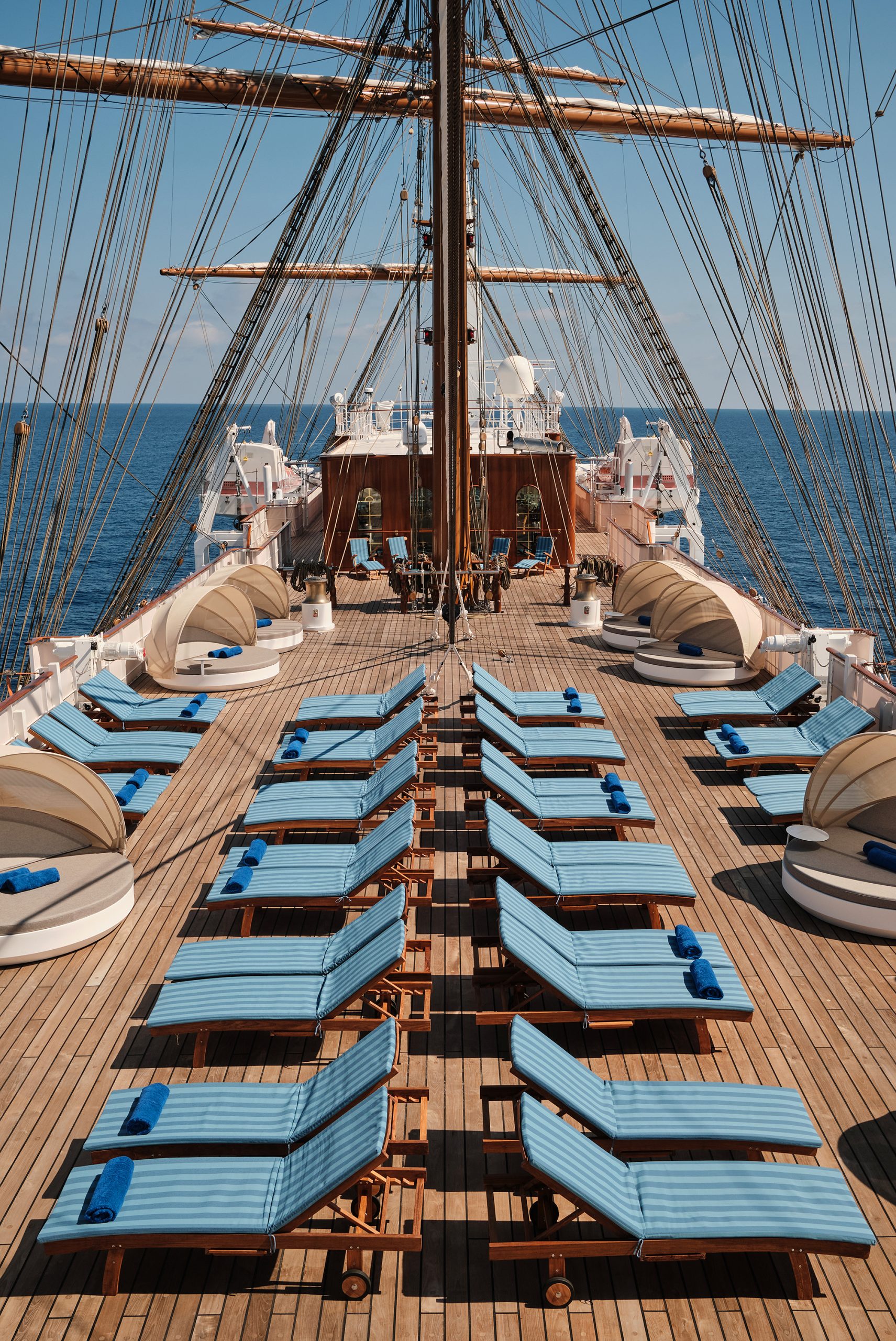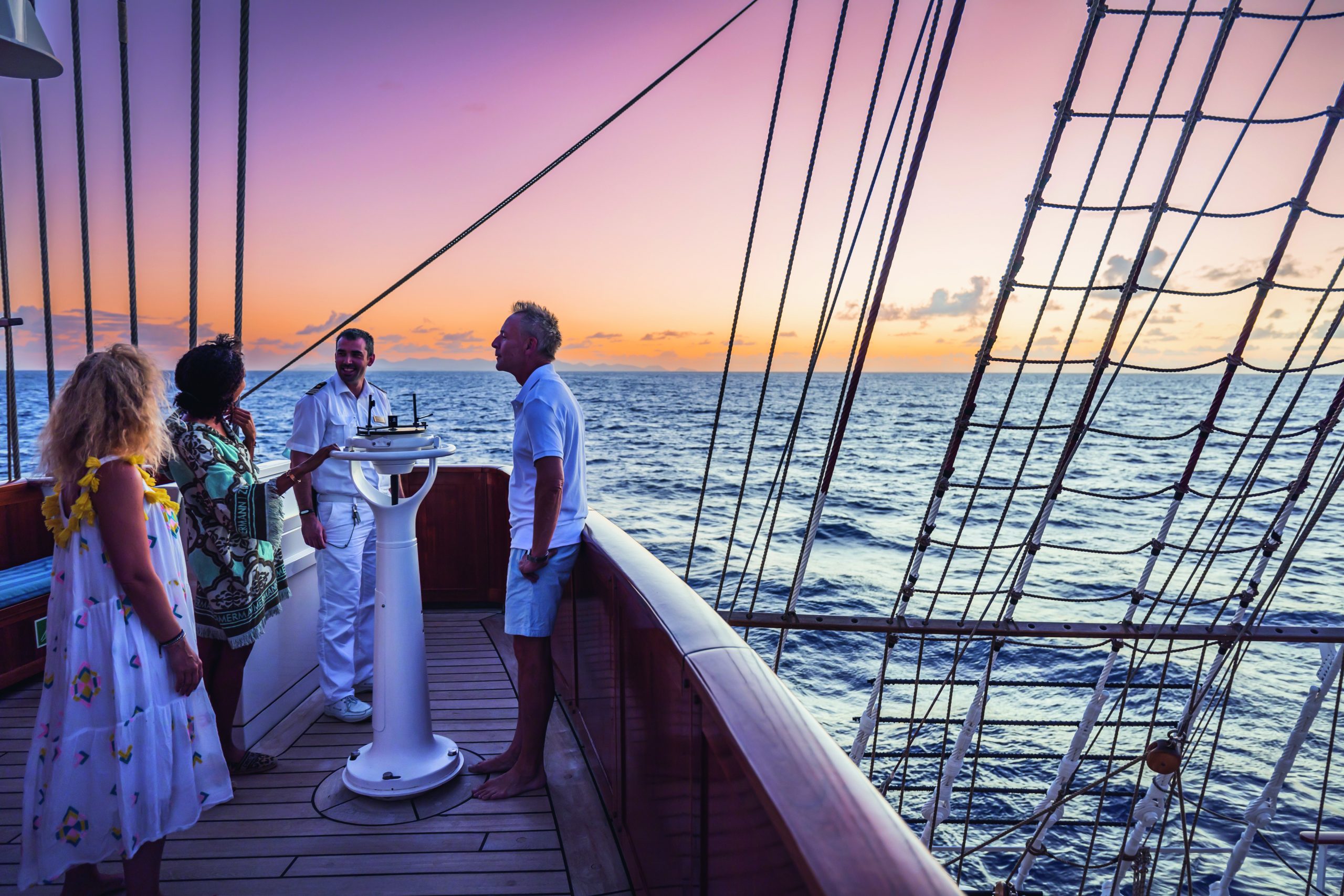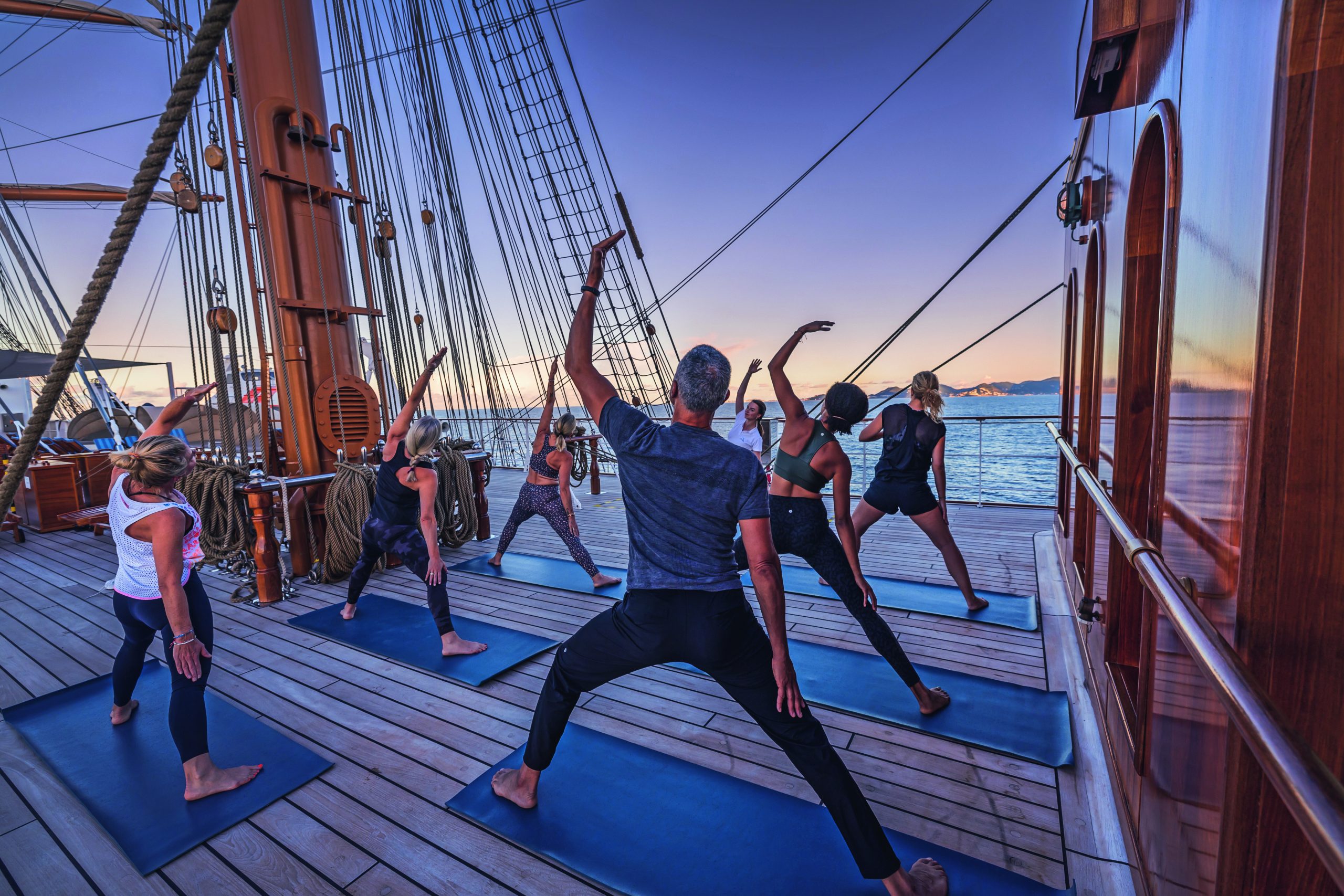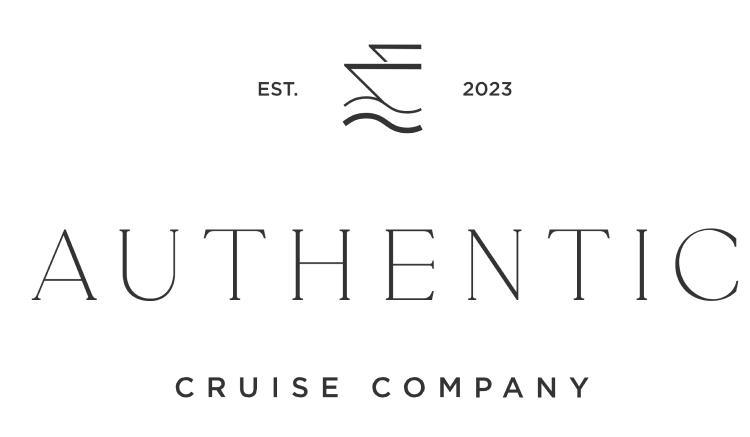Itinerary
Dutch settlers came here in the 1630s, about the same time they sailed through the Verazzano Narrows to Manhattan, bringing with them original red-tile roofs, first used on the trade ships as ballast and later incorporated into the architecture of Willemstad. Much of the original colonial structures remain, but this historic city is constantly reinventing itself and the government monument foundation is always busy restoring buildings in one urban neighborhood or another. The salty air causes what is called “wall cancer” which causes the ancient abodes to continually crumble over time. The city is cut in two by Santa Anna Bay. On one side is Punda (the point)—crammed with shops, restaurants, monuments, and markets and a new museum retracing its colorful history. And on the other side is Otrobanda (literally meaning the “other side”), with lots of narrow, winding streets and alleyways (called “steekjes” in Dutch), full of private homes notable for their picturesque gables and Dutch-influenced designs. In recent years the ongoing regeneration of Otrobanda has been apparent, marked by a surge in development of new hotels, restaurants, and shops; the rebirth, concentrated near the waterfront, was spearheaded by the creation of the elaborate Kura Hulanda complex.There are three ways to cross the bay: by car over the Juliana Bridge; by foot over the Queen Emma pontoon bridge (locally called “The Swinging Old Lady”); or by free ferry, which runs when the pontoon bridge is swung open for passing ships. All the major hotels outside town offer free shuttle service to town once or twice daily. Shuttles coming from the Otrobanda side leave you at Riffort. From here it’s a short walk north to the foot of the pontoon bridge. Shuttles coming from the Punda side leave you near the main entrance to Ft. Amsterdam.
Aruba’s capital is easily explored on foot. Its palm-lined central thoroughfare runs between old and new pastel-painted buildings of typical Dutch design (Spanish influence is also evident in some of the architecture). There are a lot of malls with boutiques and shops—the Renaissance mall carries high-end luxury items and designer fashions. A massive renovation in downtown has given Main Street (a.k.a. Caya G. F. Betico Croes) behind the Renaissance Resort a whole new lease on life: boutique malls, shops, and restaurants have opened next to well-loved family-run businesses. The pedestrian-only walkway and resting areas have unclogged the street, and the new eco-trolley is free and a great way to get around. At this writing, Linear Park was well and will showcase local merchants and artists. There will be activities along a boardwalk that will eventually run all the way to the end of Palm Beach, making it the longest of its kind in the Caribbean.
Cartagena’s magnificent city walls and fortresses, now a UNESCO World Heritage Site, enclose a well-restored historic center (the Cuidad Amurallada, or walled city) with plazas, churches, museums, and shops that have made it a lively coastal vacation spot for South Americans and others. New hotels and restaurants make the walled city a desirable place to stay, and the formerly down-at-the-heels Getsemaní neighborhood attracts those seeking a bohemian buzz. The historic center is a small section of Cartagena; many hotels are in the Bocagrande district, an elongated peninsula where high-rise hotels overlook a long, gray-sand beach.When it was founded in 1533 by Spanish conquistador Pedro de Heredia, Cartagena was the only port on the South American mainland. Gold and silver looted from indigenous peoples passed through here en route to Spain and attracted pirates, including Sir Francis Drake, who in 1586 torched 200 buildings. Cartagena’s walls protected the city’s riches as well as the New World’s most important African slave market.
Cartagena’s magnificent city walls and fortresses, now a UNESCO World Heritage Site, enclose a well-restored historic center (the Cuidad Amurallada, or walled city) with plazas, churches, museums, and shops that have made it a lively coastal vacation spot for South Americans and others. New hotels and restaurants make the walled city a desirable place to stay, and the formerly down-at-the-heels Getsemaní neighborhood attracts those seeking a bohemian buzz. The historic center is a small section of Cartagena; many hotels are in the Bocagrande district, an elongated peninsula where high-rise hotels overlook a long, gray-sand beach.When it was founded in 1533 by Spanish conquistador Pedro de Heredia, Cartagena was the only port on the South American mainland. Gold and silver looted from indigenous peoples passed through here en route to Spain and attracted pirates, including Sir Francis Drake, who in 1586 torched 200 buildings. Cartagena’s walls protected the city’s riches as well as the New World’s most important African slave market.
The San Blas archipelago is located off the Caribbean coast, east of Colon, and is made up of 365 islands that range in size from tiny ones with a few coconut palms to islands on which hundreds of Kuna Indians live. Only about fifty are inhabited. The Kuna rule the San Blas Territory with internal autonomy, and have tightly preserved their language and cultural traditions over the centuries despite influences from European colonies. In addition to their own language, Spanish is widely spoken and many men work on the mainland, but live on the islands. Women wear costumes with unique designs based on local themes, geometric patterns, and stylised fauna and flora. The island of El Porvenir is one of the main seats of government for the Kuna Indians. Many Kunas from the other islands came to settle on El Porvenir, bringing with them their traditional arts and crafts, including the famous molas. These intricately hand-sewn designs are made by the women of the tribes as part of their blouses and dresses. With the increased tourism, molas are now a favoured souvenir and craft item for visitors.
The provincial capital of Colón, beside the canal’s Atlantic entrance, is named for the Spanish-language surname of Christopher Columbus, though the Americans called it Aspinwall in the 19th century.. The city was founded in 1850 by Americans working on the Panama railroad and named Aspinwall for one of the railway engineers. Following completion in 1855, Colon gained in importance, which was furthered by the plans for an isthmian canal. During the time of the French canal attempt, a fire in 1885 burned the city nearly to the ground and left thousands of people homeless. Colon was rebuilt in the architectural style then popular in France. Buildings from that era plus the ones constructed by Americans between 1904 and 1914 are still in use today, although the majority is on the verge of collapse. In addition to its importance as a port, Colon boasts the world’s second largest duty-free zone, known as Zona Libre, which is contained in a huge fortress like, walled-off area with giant international stores. However, most of the merchandise is sold in bulk to commercial businesses throughout the country.
Ship features
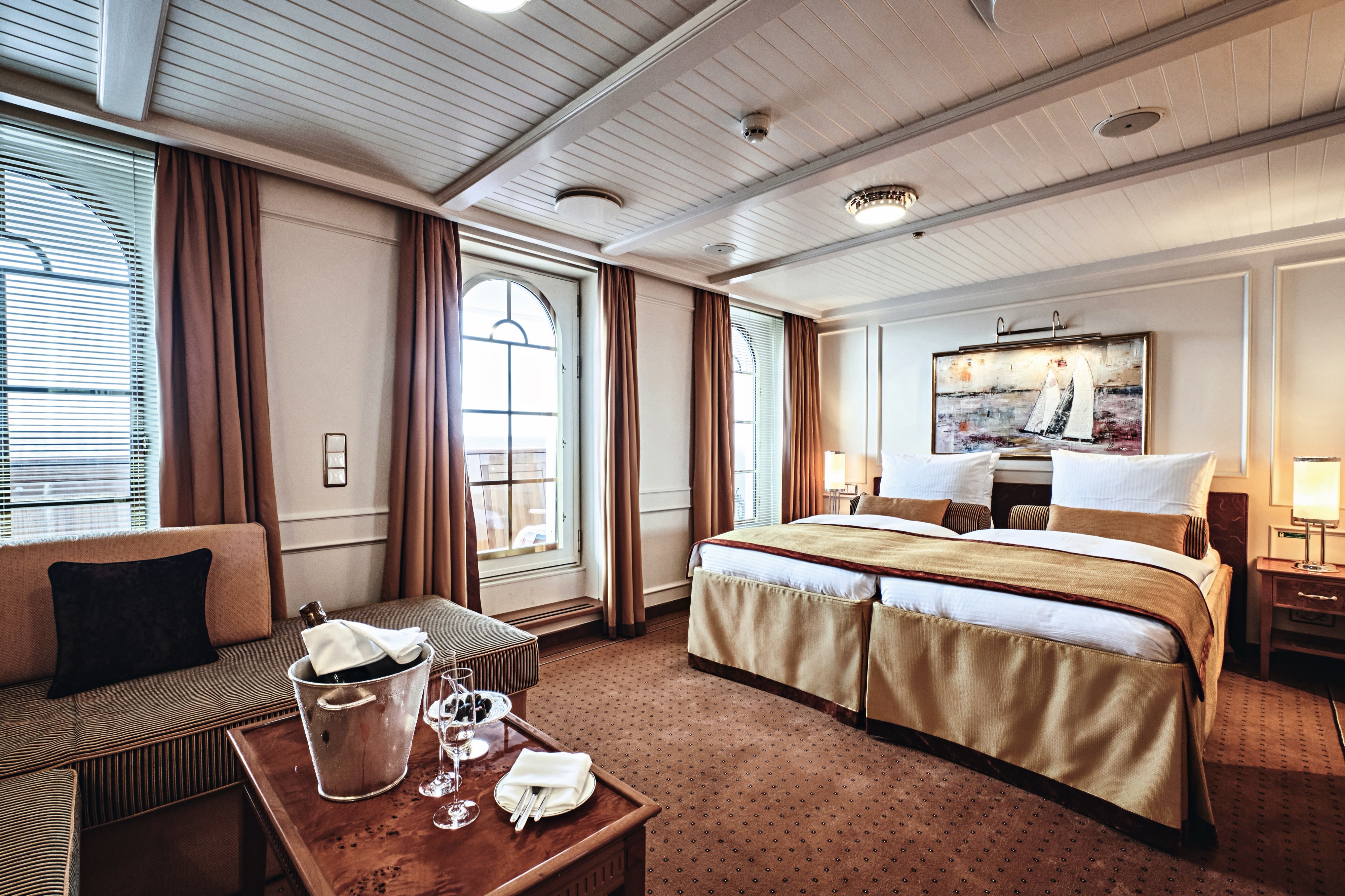
Veranda Suites (Cat. A)
The SEA CLOUD SPIRIT carries the spirit of our legendary flagship into a new era. One of the many places this is reflected is in the upscale ambience of the three suites on the veranda deck. The regal interior design combines with the spaciousness of the rooms to create sophisticated retreats. The feeling of being at the centre of an endless ocean expanse is magnified by large windows framing the majestic views. Experiencing the sea is meant literally here — on the large balcony, sailing becomes a special pleasure.
- approx. 280 sq. ft. / 26 m² to approx. 301 sq. ft. / 26 m²
- balcony approx. 86 sq. ft. / 8 m²
- marble bathroom with shower, bathtub, and golden fixtures
- California king bed, 71 in. x 83 in. / 180 cm x 210 cm (split king can be separated into 2 twins)
- walk-in closet
- L-shaped sofa with full-sized fold-out bed and table
- dressing table
- WiFi, TV, telephone
- hair dryer
- minibar and coffee machine
- safe
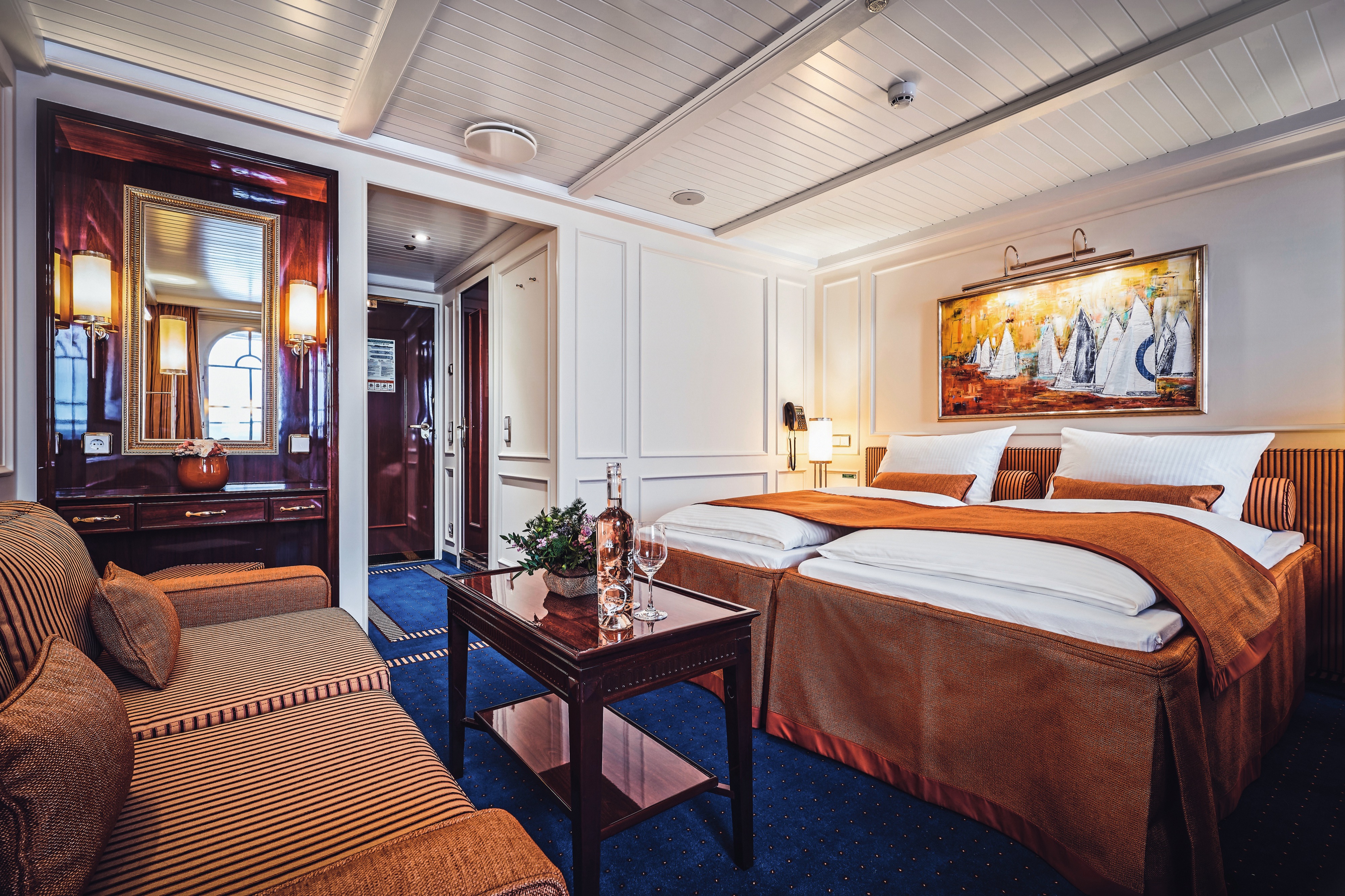
Junior Suites (Cat. B)
The junior veranda suites are also characterised by the elegant interpretation of the SEA CLOUD’s classic design and furnished with attention to detail. Rays of natural light from twin arched windows fill the space with a cheery, airy ambiance. And a private balcony lets guests get closer to the ocean and feel the sea breezes. With a bright, bold palette, lustrous woods and golden trims, these junior veranda suites epitomise the modern luxury of our newest sailing yacht.
- approx. 205 sq. ft. / 19 m² to approx. 237 sq. ft. / 22 m²
- balcony approx. 65 sq. ft. / 6 m²
- marble bathroom with shower, bathtub, and golden fixtures
- California king bed, 71 in. x 79 in. / 180 cm x 200 cm (2 mattresses)
- walk-in closet
- sofa and chair with table
- dressing table
- WIFI, TV, telephone
- hair dryer
- minibar and coffee machine
- safe
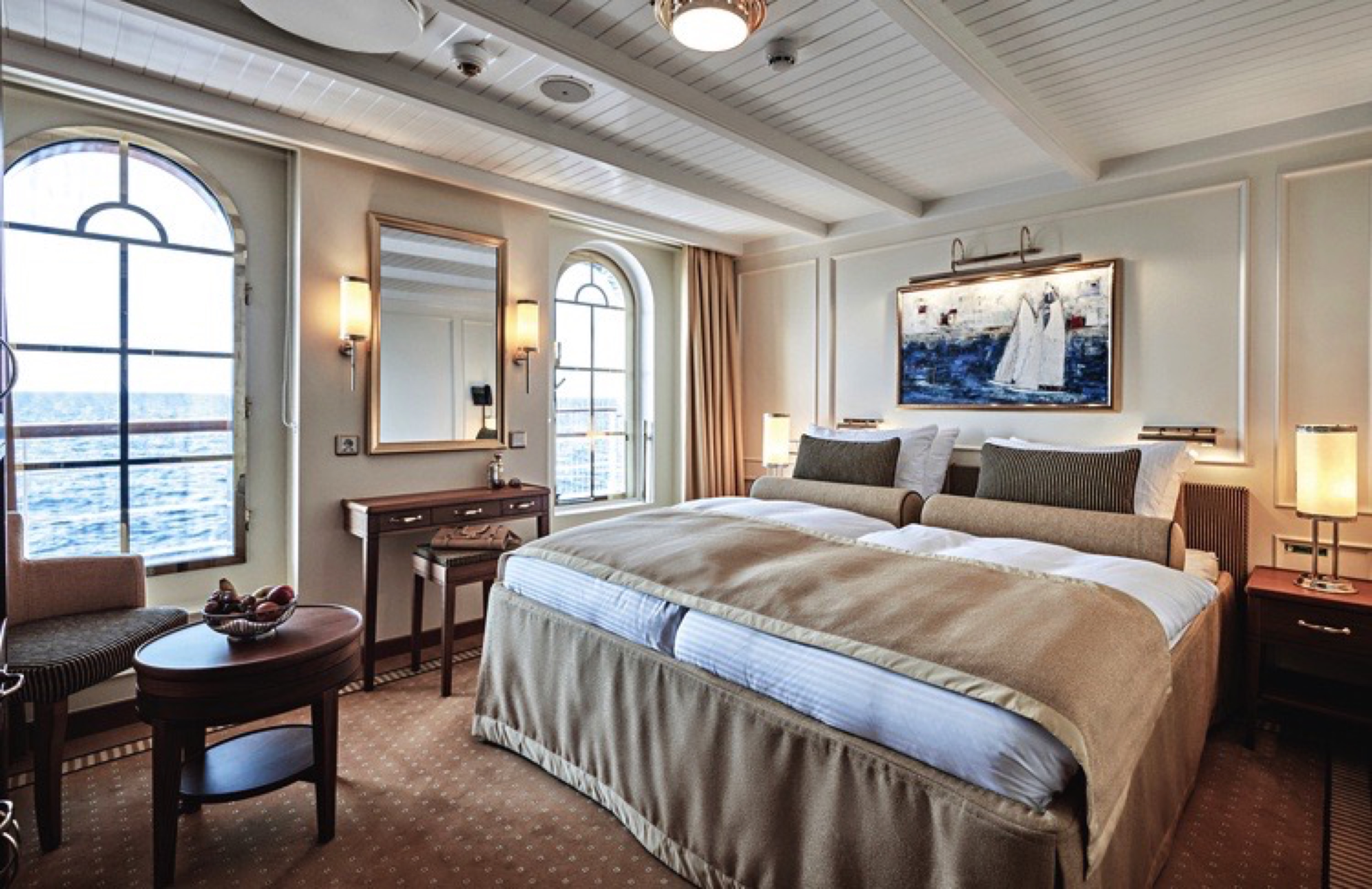
Grand Stateroom (Cat. C)
The grand staterooms on the lido deck combine the modern luxuries of a five-star hotel room with the private yacht ambiance that only the SEA CLOUD SPIRIT can offer. Elegant arched windows open to fill the space with sea breezes and a feeling of adventure. A sunny palette and golden accents create a warm glow setting the tone for a sophisticated sanctuary at sea.
- approx. 161 sq. ft. / 15 m² to approx. 194 sq. ft. / 18 m²
- opening windows
- marble bathroom with shower and golden fixtures
- double bed consisting of 2 singles, 35 in. x 79 in. / 90 cm x 200 cm
- closet
- chair with table
- dressing table
- WIFI, TV, telephone
- hair dryer
- minibar and coffee machine
- safe

Deluxe Stateroom (Cat. D)
Large porthole windows give these SEA CLOUD II deluxe staterooms a special maritime flair. With a luxurious yacht ambience, these upscale spaces magnify the feeling of being part of an extraordinary journey on an extraordinary ship. The spacious room exudes elevated coziness with sophisticated furnishing and finishings, a glamorous palette and charming sitting area.
- approx. 194 sq. ft. / 18 m² to approx. 226 sq. ft. / 21 m²
- marble bathroom with shower and golden fixtures
- California king bed, 71 in. x 79 in. / 180 cm x 200 cm (2 mattresses)
- closet
- seating with table
- dressing table
- WIFI, TV, telephone
- hair dryer
- minibar and coffee machine
- safe
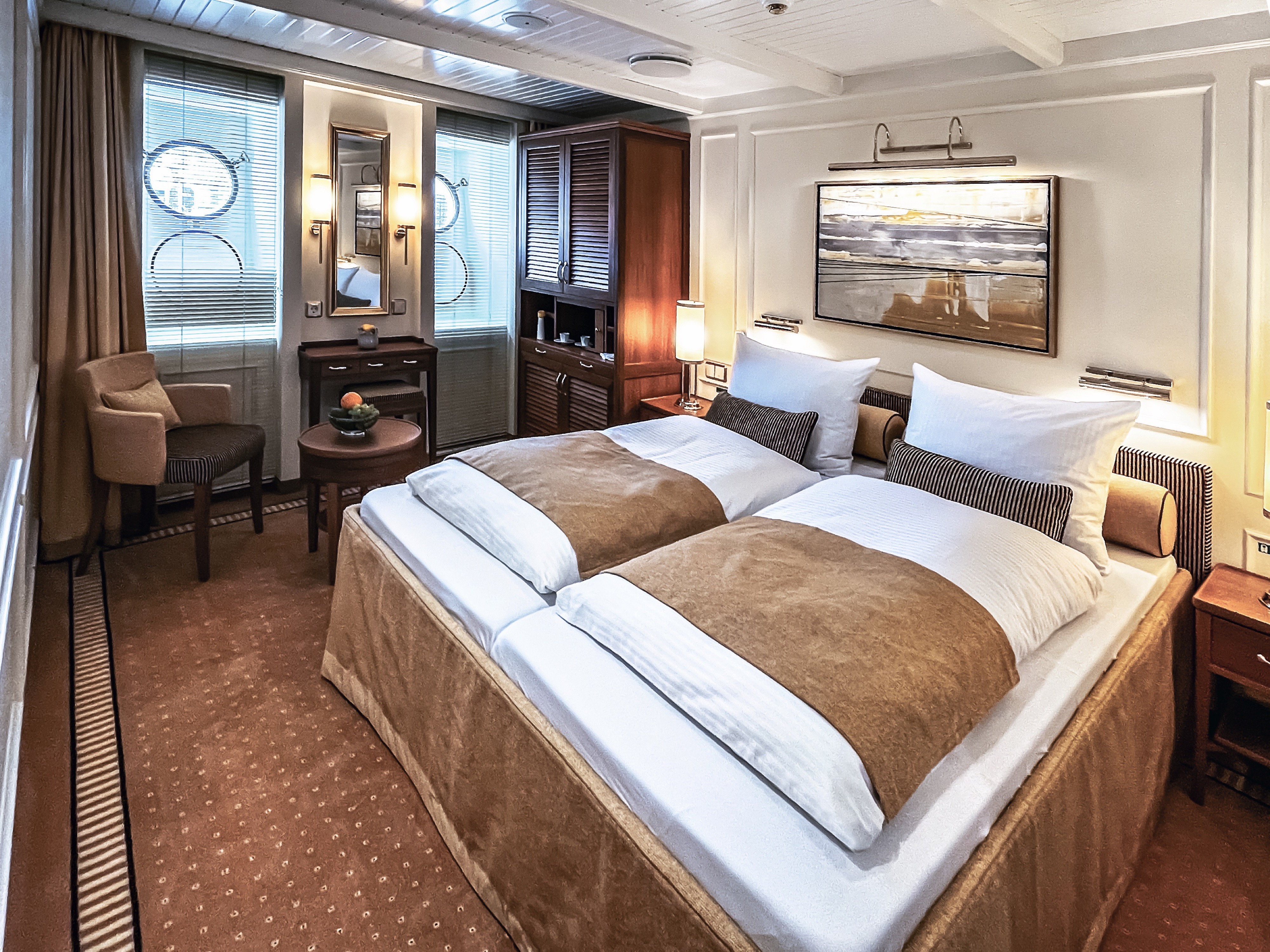
Superior Stateroom (Cat. E)
These outside superior staterooms with large porthole windows are the epitome of nautical luxury on SEA CLOUD SPIRIT. These are exclusive retreats of serenity that have made our sailing yachts famous. Sophisticated style comes in the form of rich wood finishings, Italian marble and golden fixtures.
- approx. 172 sq. ft. / 16 m² to approx. 205 sq. ft. / 19 m²
- marble bathroom with shower and golden fixtures
- California king bed, 71 in.x 79 in. / 180 cm x 200 cm (2 mattresses)
- closet
- seating with table
- dressing table
- WIFI, TV, telephone
- hair dryer
- minibar and coffee machine
- safe

Superior Single Stateroom
The two superior single staterooms charm single travelers who want to enjoy the luxury comforts of the SEA CLOUD SPIRIT. In slightly smaller spaces, they offer the same upscale design and decor as the deluxe staterooms on the stern side of the deck, complete with nautical portholes. And restful nights are guaranteed in the unique built-in bed, with a width of 43 or 47 inches at the head, 63 or 69 inches at the foot and a length of 87 or 91 inches.
- approx. 140 sq. ft. / 13 m²
- marble bathroom with shower and golden fixtures
- built-in single bed
- closet
- chair
- dressing table
- WIFI, TV, telephone
- hair dryer
- minibar and coffee machine
- safe

Guarantee Double
Guaranteed stateroom: Space is limited. Allocations are at SEA CLOUD CRUISES’ discretion starting in Category E. You will receive your exact stateroom number when arriving on board.
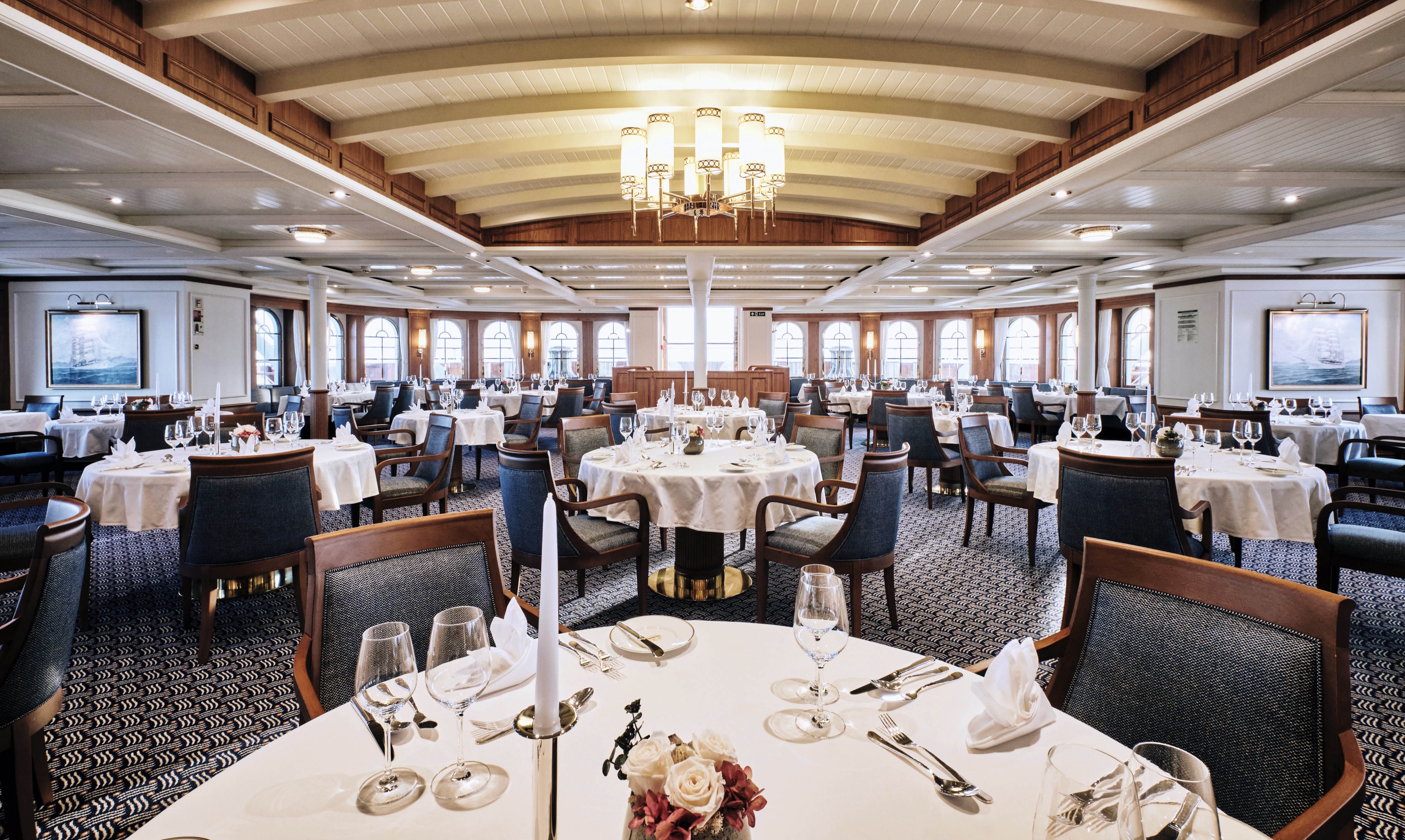
Restaurant & Lido Deck with Bistro
Meals are served on our ships in one seating. Service times can be found in the daily program on board. Please kindly note that reservations are not possible. As an alternative to fine dining in the restaurant, you can enjoy a casual dinner in the bistro on the lido deck (SEA CLOUD SPIRIT only).
A small breakfast with pastries and fruits is offered to early and late risers onboard the SEA CLOUDs. On the SEA CLOUD, it’s located on the Panorama Deck (early risers) or the Lido Deck (late risers). On board the SEA CLOUD II and the SEA CLOUD SPIRIT, a small breakfast is available at the Lido Bar. The main breakfast buffet is provided in the restaurant. Lunch is served as a buffet on the lido deck or in the restaurant. In the afternoon, coffee and tea are served, accompanied by some sweet treats and sandwiches. Dinner is a four-course menu with entrees to choose including a vegetarian option. Our executive chef will prepare an exclusive five-course meal for the gala dinner. The Bistro on the lido deck offers a flexible and casual alternative to dinner in the restaurant (SEA CLOUD SPIRIT only). A late-night snack nicely rounds up the evening’s culinary delights.
We maintain the tradition that at the beginning and towards the end of a voyage, the captain invites you to a Captain’s Cocktail, followed by a (Captain’s) Gala Dinner in the restaurant. For this occasion, we recommend elegant cocktail attire.
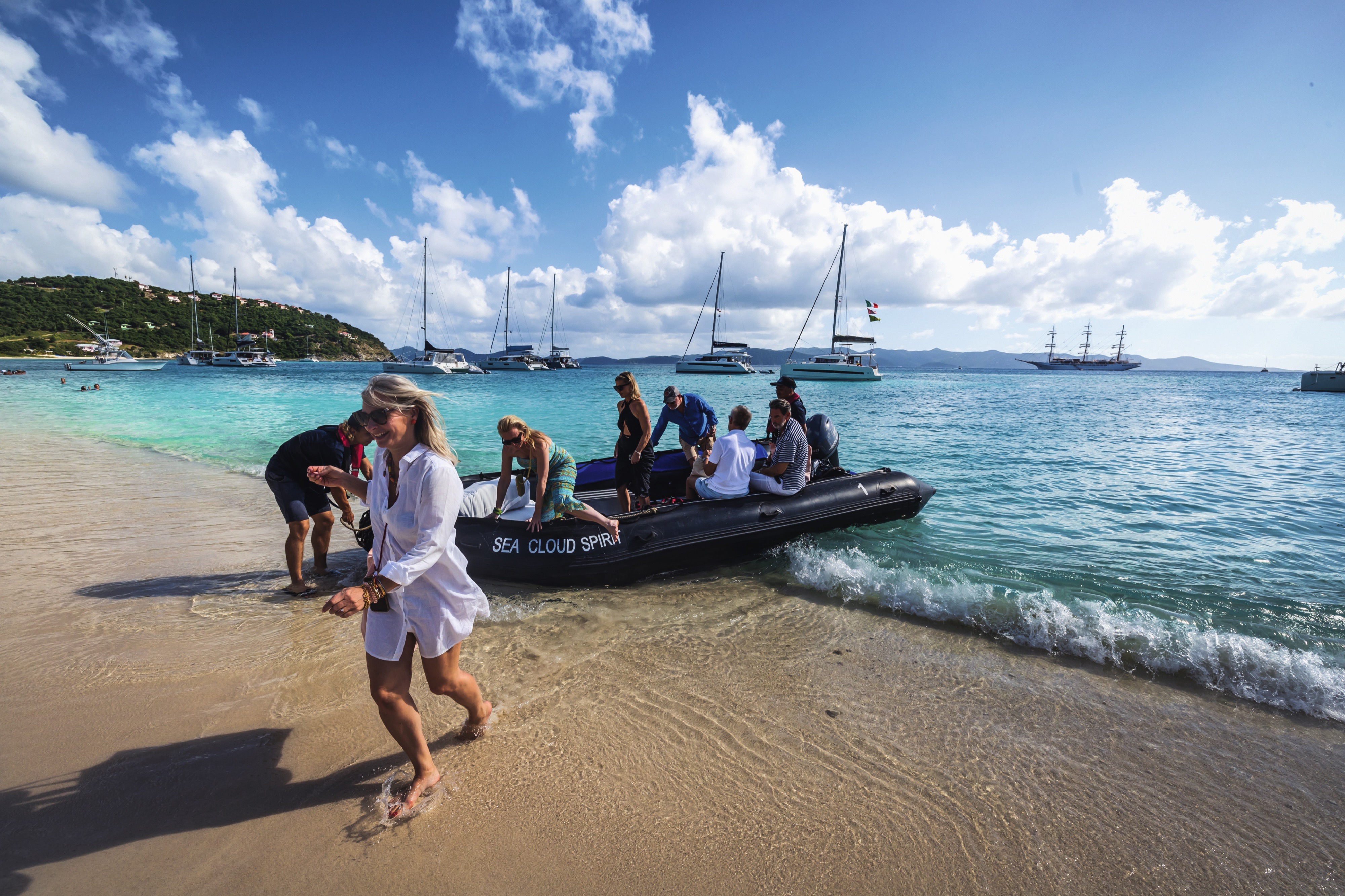
Zodiacs
Zodiacs are small motor-driven rigid-hull inflatable boats with a capacity of approximately 8 to 10 guests, primarily used for beach landings on our cruises or our photo safaris.
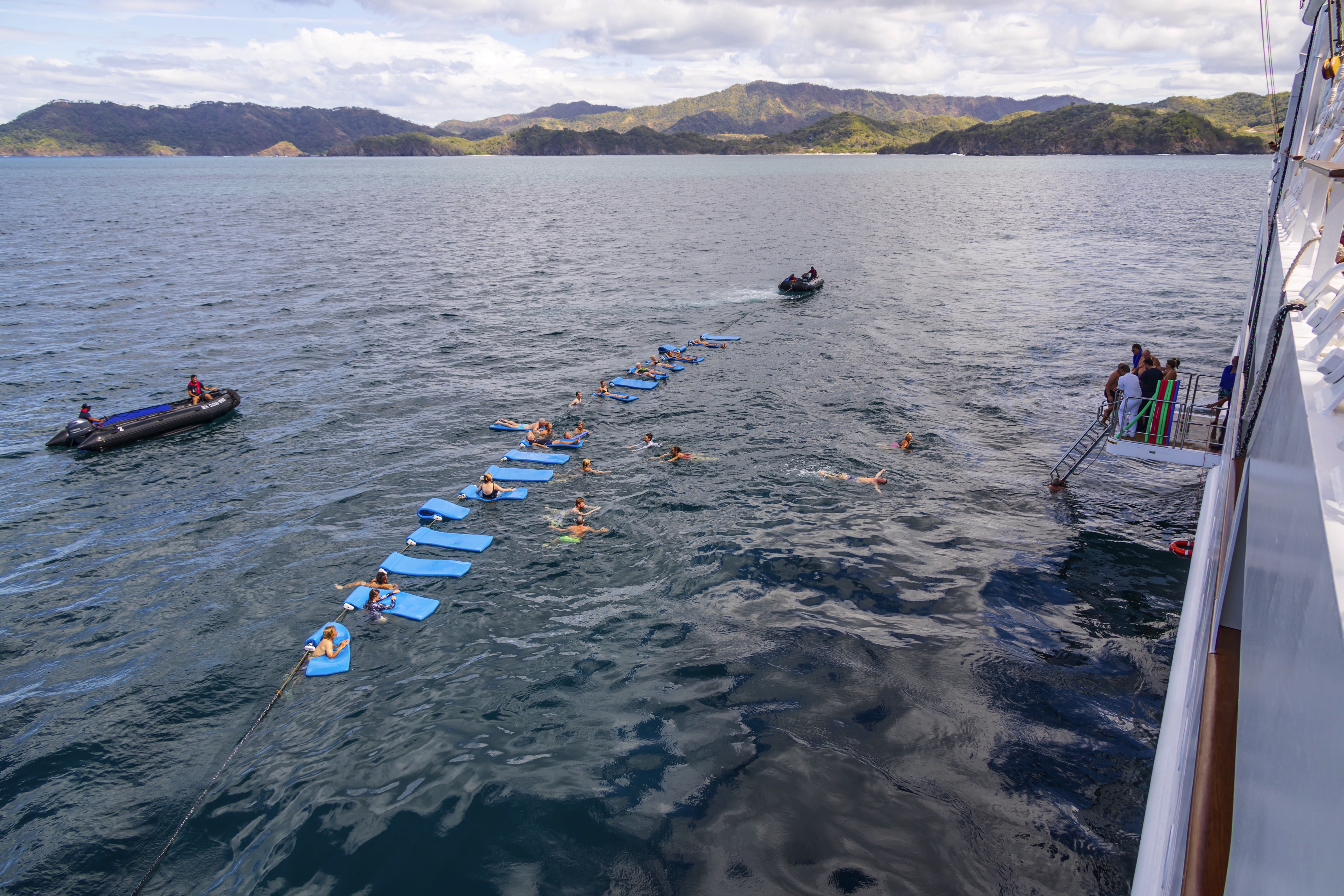
Watersports and Swimming
Water sport activities are offered from the marina platform.
We do have snorkelling equipment in different sizes on board, stand-up paddle bards for beach landings and a towable tube from the gangway.
All water sport activities are included and subject to weather and Captains permission.
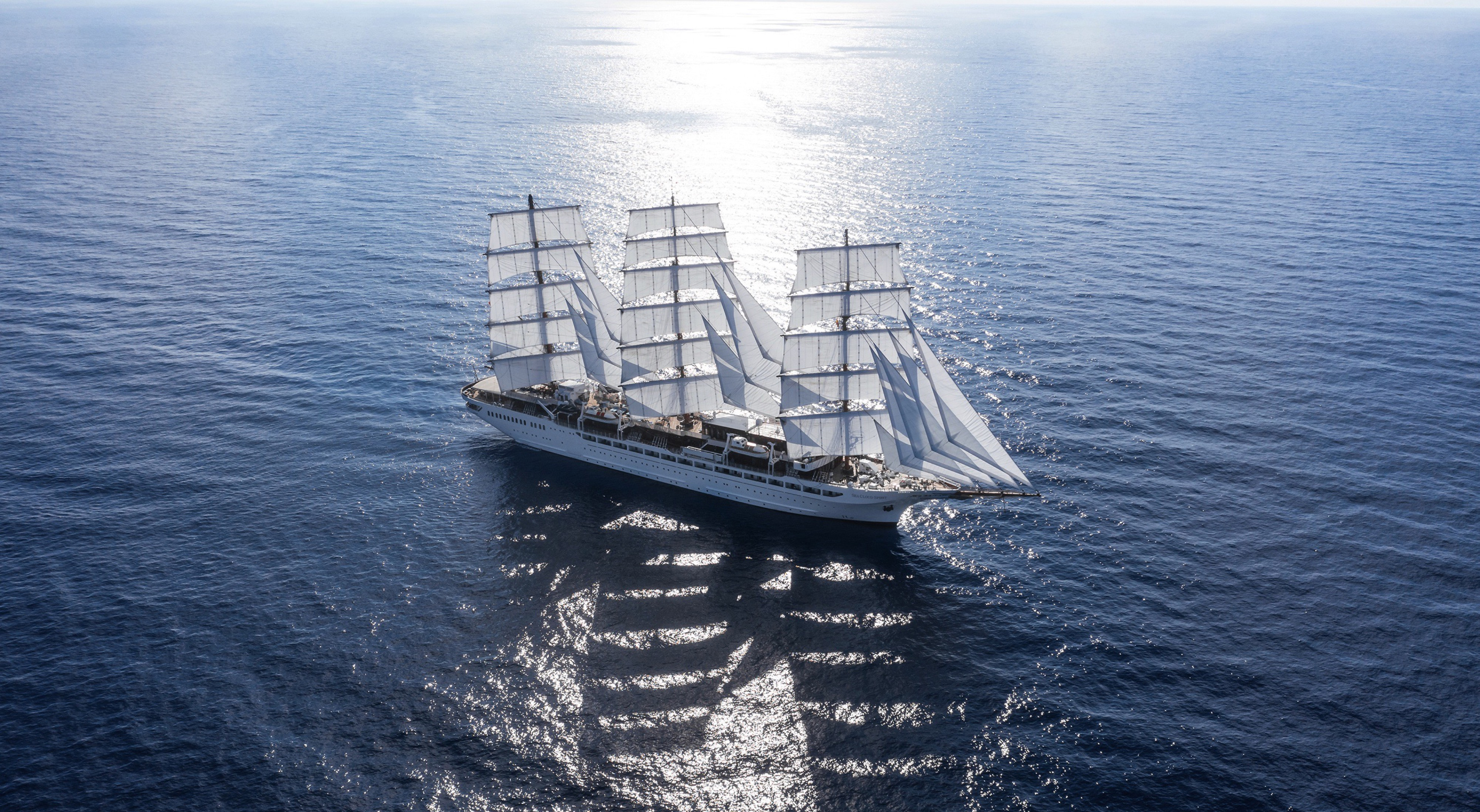
Excursions
All our shore excursions are shown on the itinerary pages of our brochure. 4 weeks prior to departure you will receive detailed information on shore excursions with your travel documents. The shore excursion booklet also includes the order form to pre-book your excursions. On board the Cruise Director will be able to provide further details during a lecture. We do recommend pre-booking prior to embarkation to secure your spot. All excursions will be charged to your cabin account on board.
You are free to join an organised shore excursion, stay on board or make individual arrangements. You will find times for tender or to be back on board in your daily program and at the gangway.
Please remember to bring comfortable footwear, a light jacket/windbreaker, as well as sunscreen where appropriate.
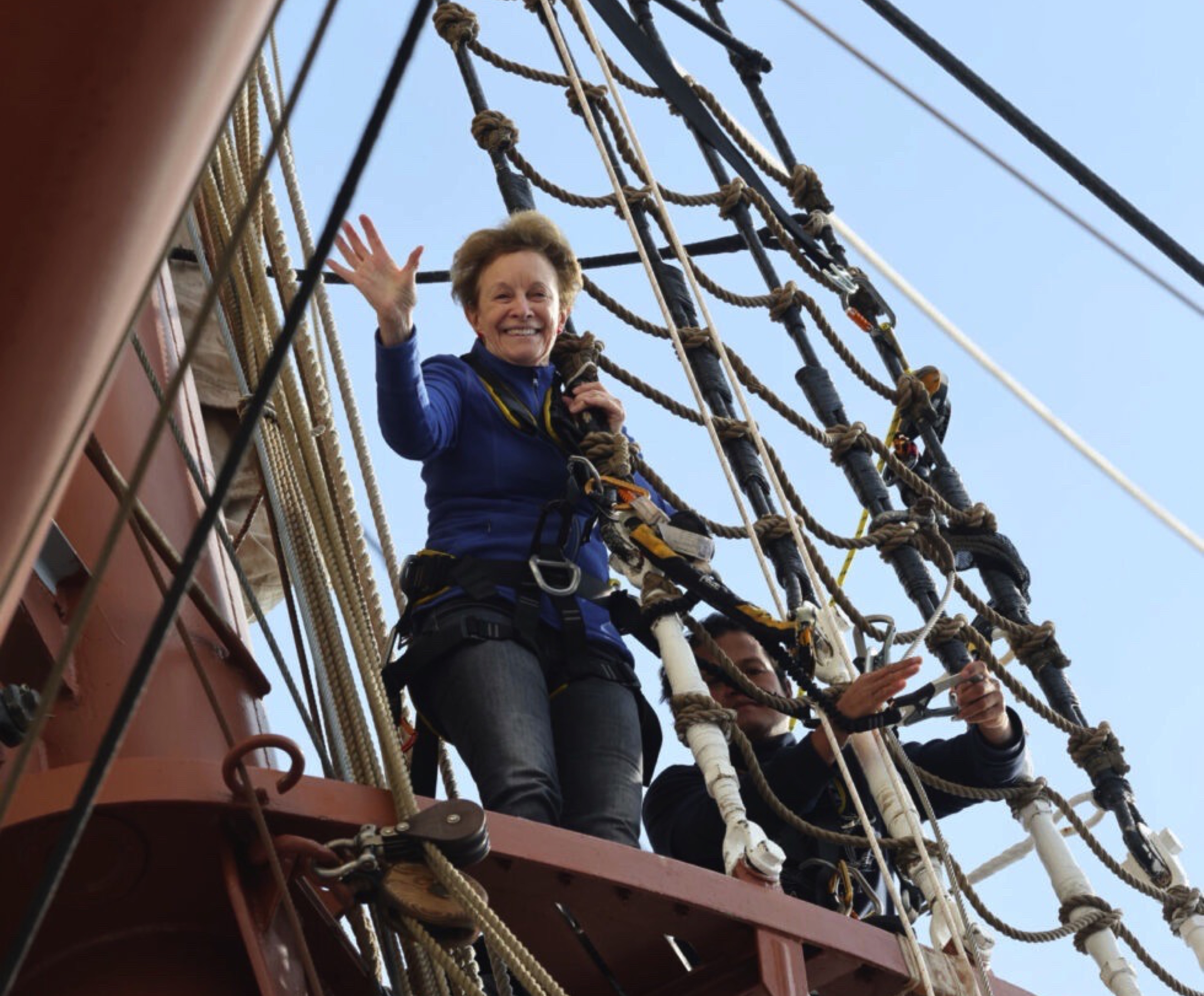
Rigg Climbing
Join us for some rigg climbing
One of the most captivating experiences onboard the SEA CLOUD windjammer is watching the crew climb into the rigging to set the sails by hand. Now, you can share a piece of this adventure yourself and – if your fitness allows – climb up to the first platform!
Our SEA CLOUDs are the only cruise ships in the world that are traditionally sailed by hand. Here, nothing happens at the push of a button: setting the sails follows centuries-old rituals, bringing the magic of sailing to life in a unique way. Now, you can experience this tradition up close! High up in the rigging, carried by the wind and with sweeping views over the sea, you’ll feel the majestic power of our tall ships even more intensely. Safely guided and equipped with state-of-the-art safety systems, you can climb up to the first platform, about 14 meters above the deck – an unforgettable moment for those seeking adventure!
A brief fitness check on board ensures that you feel completely comfortable and secure before you ascend. This includes: hanging from a bar for 10 seconds, balancing on one foot for 20 seconds and climbing stairs two at a time. Our experienced deckhands, specially trained for these activities, will guide you every step of the way so you always feel safe and well taken care of.
Embark on this unique adventure now – a once-in-a-lifetime moment that will leave you with a deep sense of joy and a touch of pride. Are you ready to experience the sea in all its splendour, high above the sails?
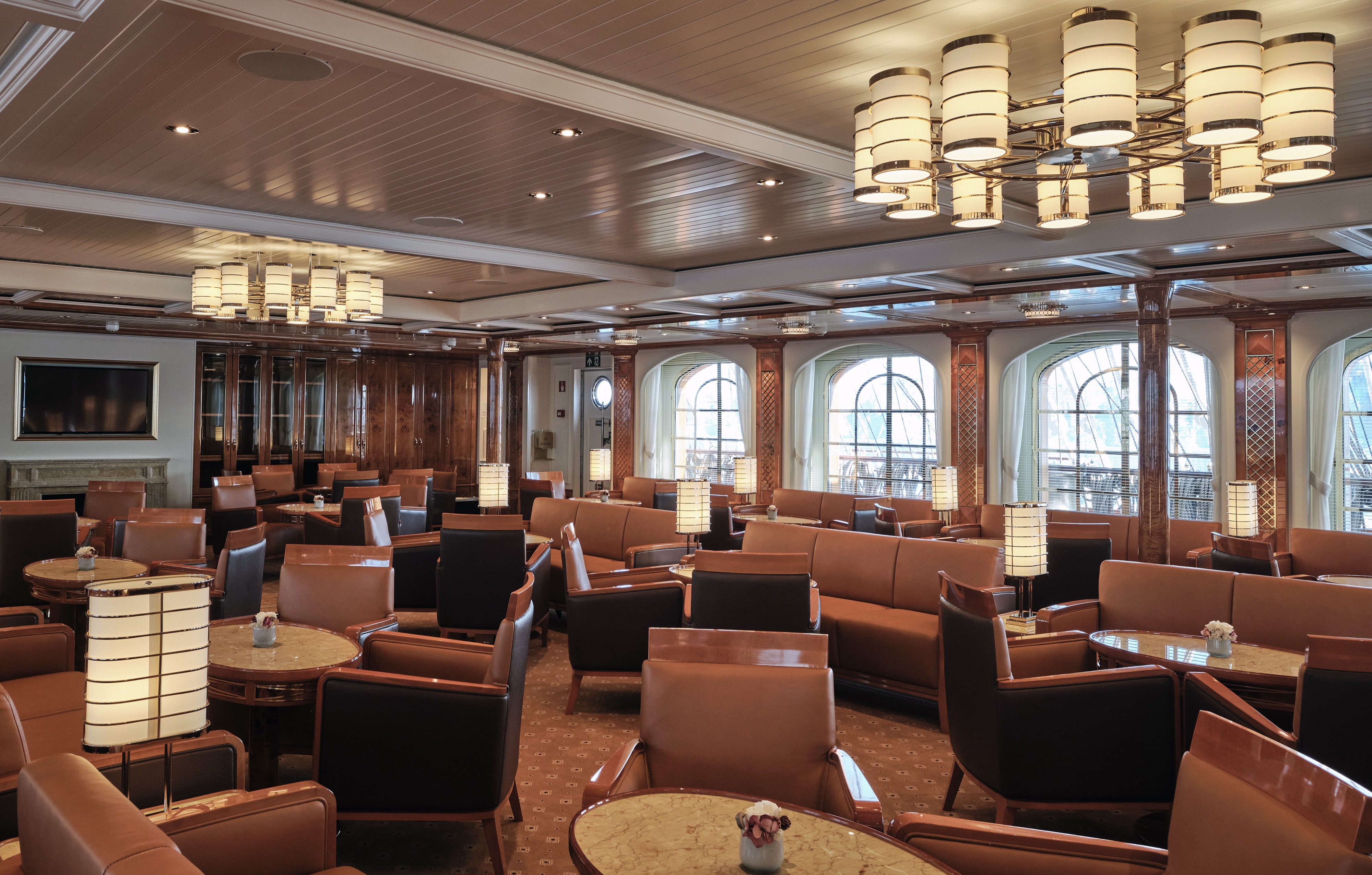
Lounge
The lounge is located on the Lido Deck and is always open. This is where all lectures take place and on select sailings concerts on the Steinway grand piano. Enjoy a selection of games or just an afternoon snack.

Library
Sit back and relax in our library with a great selection of books and popular board games. Feel free to take them during your trip and place back before your journey ends.
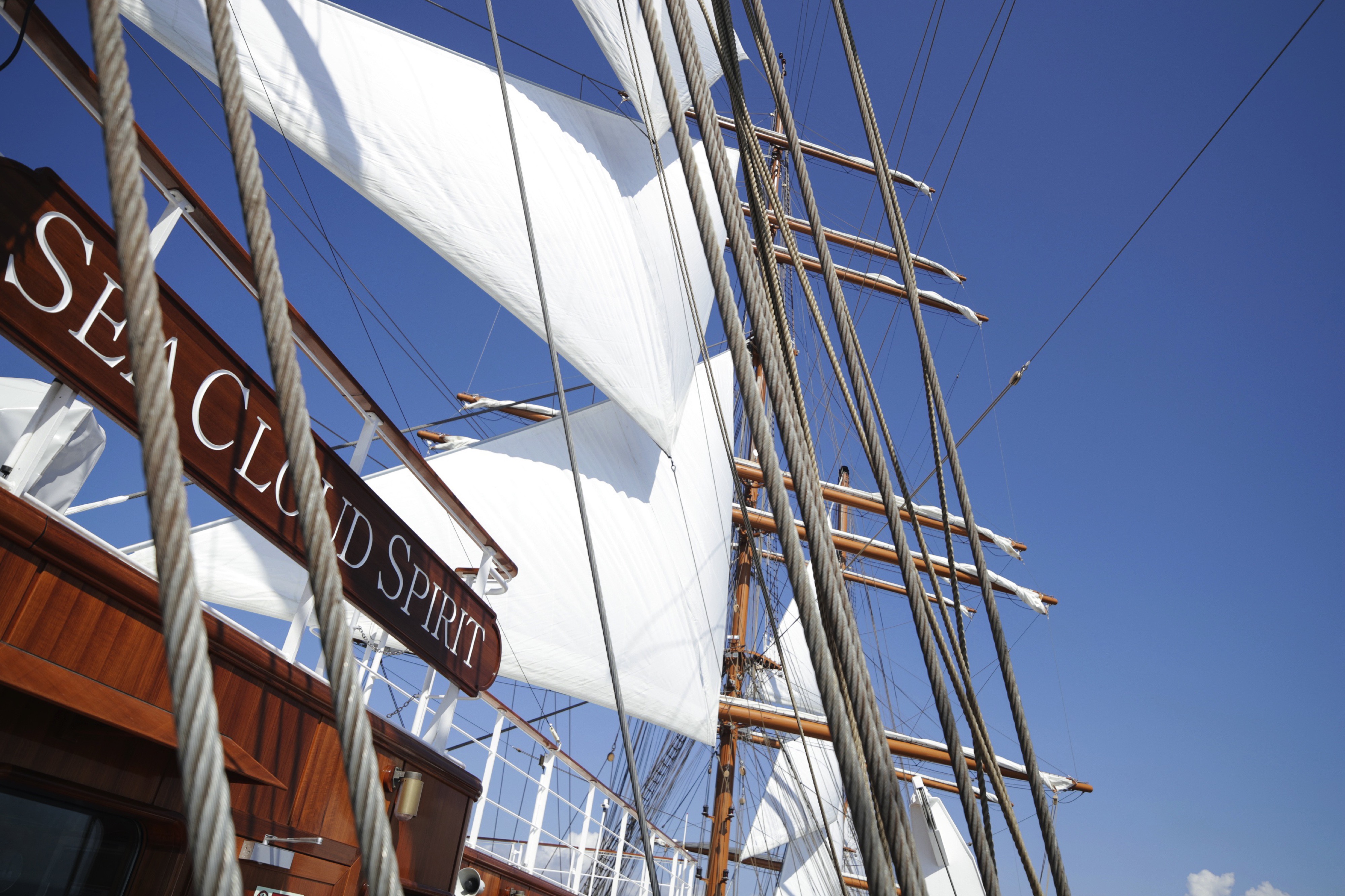
Sun Deck
On board SEA CLOUD SPIRIT, the deck chairs and sun loungers are located on the sun deck. We kindly ask you to respect your fellow travellers and refrain from reserving sunbeds and chairs.
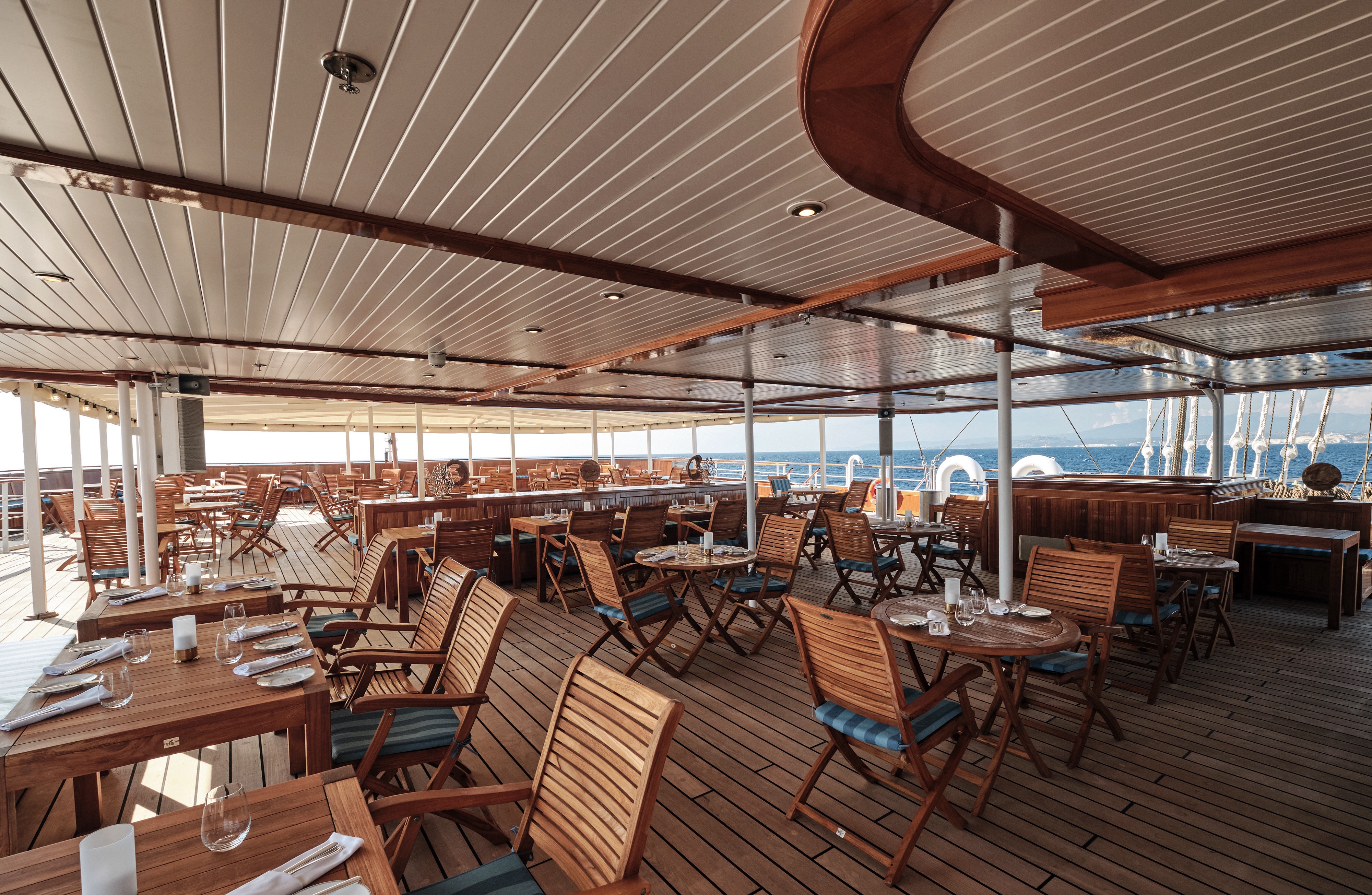
Lido Deck with Bar
- During evening and cocktail hours, we do have soft entertainment in the Lido Bar.
- Lunch is served as a buffet on the lido deck or in the restaurant.
- The Bistro on the lido deck offers a flexible and casual alternative to dinner in the restaurant
- A small breakfast is available at the Lido Bar.

Boutique
The boutique on our yachts offers accessories, clothes, and gifts. Opening hours vary. You will find the exact information in the daily program and on the public boards. Feel free to contact the reception with any questions or requests outside of opening hours.

Fitness & Sun Deck
The fitness area of the SEA CLOUD SPIRIT is located on the sun deck. It is open during the day and is equipped with modern cardio equipment and weights.
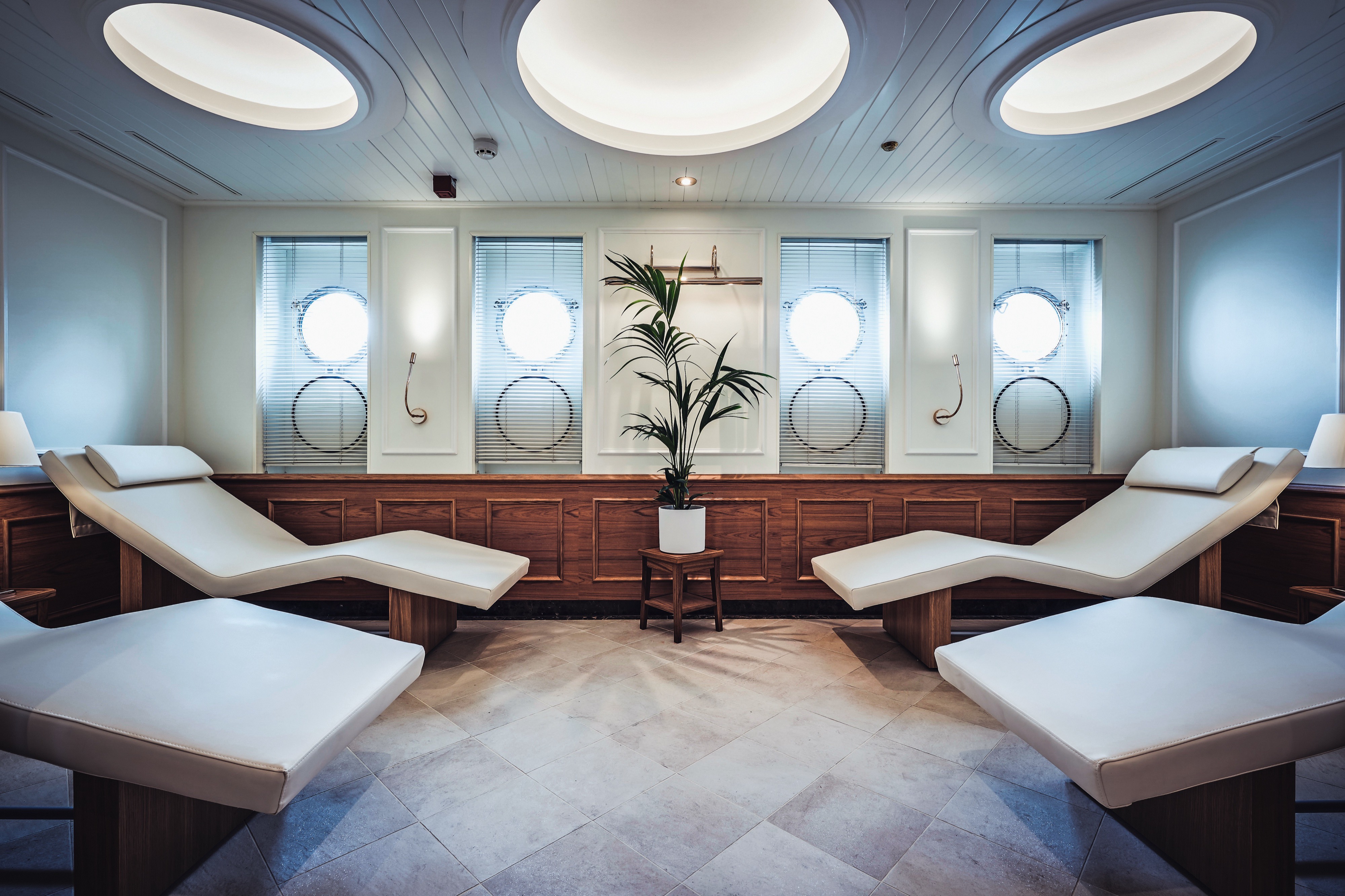
Spa and Wellness
SEA CLOUD SPIRIT has an extensive wellness and spa area with two treatment rooms, Finnish sauna, steam bath, relaxation room and multi-sensory shower. We offer massages, and various treatments at an additional charge. The Spa Brochure with our detailed program is available in your cabin. You can book your appointments at the reception.
Special Dietary Requirements
Please inform us prior to your cruise if you have any allergies, intolerances, or other special dietary restrictions. We will try to accommodate your needs as far as possible.
Dress Code
During the day, we recommend casual chic, yachting clothes. The evenings are casual elegant. Please refrain from wearing swimwear during lunch and/or shorts at dinner. For the Captain’s Dinner (once or twice depending on lengths of the cruise), we recommend elegant cocktail attire, a suit or ensemble for the gentleman and matching dress for the lady. We additionally suggest bringing non-slippery boat shoes.
Disabled Access
Our windjammers, SEA CLOUD, SEA CLOUD II and SEA CLOUD SPIRIT, are not barrier-free and, therefore, unsuitable for wheelchair users. Please contact our reservations directly for details.
There are no elevators on the SEA CLOUD and SEA CLOUD II, only staircases. SEA CLOUD SPIRIT is equipped with an elevator. You will access and depart the ship via the onboard gangway, which is not always level. Depending on weather conditions, access might be steep. The tenders or zodiacs service is done via the gangway. Please contact us prior to cruise if you have any questions regarding accessibility. If you need specific medical arrangements, please contact us in advance.
Smoking Policy
Smoking is permitted only on the lido deck outside of mealtimes. We kindly request that smokers take the other passengers into consideration. Smoking is always prohibited in covered areas on the lido deck, of the spanker deck (SEA CLOUD), on the blue lagoon (SEA CLOUD II), on the sun deck and on the verandah (SEA CLOUD SPIRIT).
Laundry Services
Laundry services on board are limited to washing and ironing. There is no dry cleaning available. You will find a price list for the overnight laundry and ironing service in your closet. For guests who have booked a suite in category A-C (SEA CLOUD) or category A+B (SEA CLOUD II & SEA CLOUD SPIRIT) the laundry service complimentary. For safety reasons, passengers are not permitted to iron in their cabins.
WI-FI
Each of our yachts is equipped with Starlink satellite internet. All three ships offer WI-FI access in the public areas and in the staterooms. You can use your own laptop to access the Internet with an access code (WI-FI). Data volume of 10 GB is free of charge; additional data volume can be obtained from the reception desk at a charge. Continuous reception cannot be guaranteed; in certain sailing areas or due to the set course, interruptions to network coverage might be experienced. The WI-FI connection on a ship is not comparable to the usual reception on land.
On board, a laptop that is located in the lounge (SEA CLOUD) or in the library (SEA CLOUD II & SEA CLOUD SPIRIT) can be used for e-mail use on board. The SEA CLOUDs have their own on-board email addresses as follows:
SEA CLOUD: seacloud@seacloud.com
SEA CLOUD II: seacloud2@seacloud.com
SEA CLOUD SPIRIT: passenger@scs.seacloud.com
Please advise anyone you give the above email address to not send messages with attachments. Please put your name and cabin number in the subject line to ensure that the reception can forward any correspondence to you. They will hand you a printout of the e-mail.
Incoming and outgoing e-mails up to 50 KB in size can be received or send free of charge. However, files larger than 50 KB per message are automatically rejected by the system.
Due to limited network availabilities at sea, cell phones use is limited. The SEA CLOUDs are equipped with Starlink that ensures WIFI connection. Phone numbers to reach the ship can be found in your travel documents and on board.
Children on Board
Children are welcome on our ships, but please keep in mind there is no daycare or special entertainment for children on board our ships.
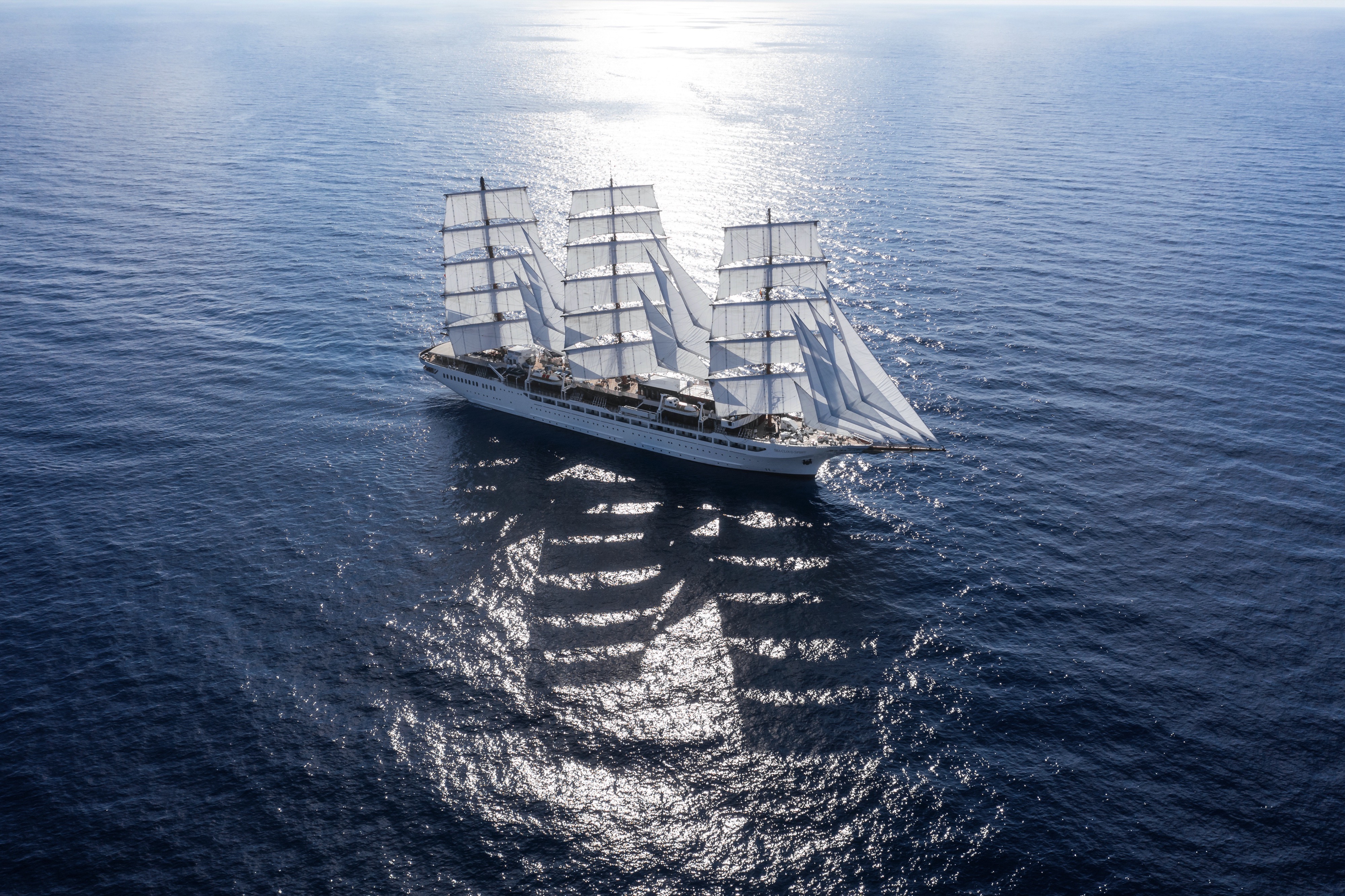
Sustainability & Low Impact Tourism
OUR CONTRIBUTION TO ECO-FRIENDLY TRAVEL
We approach the people and their cultures with respect in all the regions we visit, travelling mindfully through the local environment. By doing this, we can bring our guests closer – in the truest sense of the word – to these places, and what makes each one special.
THE WINDJAMMER EXPERIENCE
For you and us alike, the key attraction of our trips is the chance to sail on the open seas.
We therefore take every opportunity to set sail and be propelled by the sheer power of the wind. That is why the captain will sometimes change the route if the weather requires it. On board our SEA CLOUD tall ships, you’ll experience the elements, as many of the day-to-day activities take place outside.
HAVING AS LITTLE IMPACT AS POSSIBLE
When we do have to start the engines, we utilise low-sulphur marine diesel on all three of our windjammers.
For us, this is standard practice. Even the SEA CLOUD, our very first windjammer, was equipped with this technology right from the start. Our motto: to minimise our impact on the environment yet still make a profound and positive impression on those around us.
A SUSTAINABLE APPROACH TO LIFE ON-BOARD
Avoiding plastic, reducing water usage and protecting the environment.
These are the factors that guide us in the day to day operation of our ships and our ongoing development of eco-friendly alternatives. To cite just one example, our reusable drinks bottles are not only easy on the eye, but also easy on the environment.
QUALITY, NOT QUANTITY
Our ‘small but perfectly formed’ windjammers are able to visit smaller ports, away from the busy routes frequented by large cruise liners.
With a maximum of 64 to 136 passengers, we’re always welcomed in those locations thanks to our approach of visiting local communities rather than overwhelming them. Needless to say, our itineraries also include some classic destinations, though we usually visit these only when the mega-liners have moved on.
BOOSTING THE LOCAL ECONOMY
Procuring supplies locally, working with local, smaller-scale agencies and paying fair prices.
By taking this approach, we see ourselves as a partner for our local service providers, with whom we’ve built relationships based on trust over many years. After all, we want our voyages to benefit both our guests and the communities we visit around the world.
AUTHENTIC CUISINE
Our menus are always a true reflection of the regional cuisine.
This is because our chefs enjoy buying exotic spices, local specialities and freshly caught fish from local markets to bring you – even in a culinary sense – closer to the places we visit.
A MEMBER OF THE FUTOURIS NETWORK
Heading into the future with Futouris.
Preserving the natural and cultural heritage of our world and shaping the future of tourism in a sustainable way is what Futouris stands for. Members of the network are working globally to improve people’s living conditions, preserve biodiversity and protect the environment and climate.
Medical Facilities
All three ships have a clinic and a ship’s doctor. Medical consultation hours can be found in the daily program. In case of an emergency, the doctor can be reached at any time by calling 911.
What's Included
Complimentary with your sailing:
- Welcome champagne in suite/stateroom
- Daily fresh fruit basket in suite/stateroom
- All meals including nightly 4-course menu and a 5-course gala dinner
- Fine wines from renowned winemakers and beer for lunch and dinner
- All non-alcoholic coffee and tea specialties
- All soft drinks
- Welcome and farewell cocktail
- Bottled water on excursions
- Gratuities and port fees
- Curated moments
- Beach barbecues in select destinations
- Marina platform with use of water sports equipment such as snorkel gear, stand-up paddleboards, and towable tube (weather permitting)
- Laundry service in suites

Sun Deck
- Fitness Area
- Self-Service Bar
- Captain
- Bridge
- Shower
- Sun Deck
- Elevator

Lido Deck
- Lido Bar & Bistro
- Lounge
- Elevator
- Library
- Grand Stateroom

Veranda Deck
- Restaurant
- Reception
- Veranda Suites
- Junior Veranda Suites

Cabin Deck
- Deluxe Staterooms
- Superior Cabins
- Superior Single Cabins
- Elevator
- Hospital
- Swim Platform
- Relaxation Room
- Finnish Sauna
- Shower
- Foot Bath
- Treatment Rooms
- Boutique
- Stream Bath
